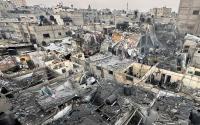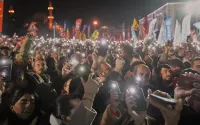30 December 2004Guardian
They have survived for thousands of years in one of the world's most isolated areas. But at least two of the Stone Age aboriginal tribes that live on the remote Andaman and Nicobar Islands have been gravely affected by Sunday's giant tsunami, which ripped through the sprawling archipelago in the Bay of Bengal, killing at least 3,000 people.
Yesterday the Indian authorities here admitted they were dealing with a disaster - and said they had been unable to make contact with the Shompens, a reclusive tribe who live on the island of Great Nicobar.
Officials said they were sending messengers to some of the most remote islands, more than 16 hours away by boat, to ascertain who was left alive.
The relief operation has been made more complicated by the fact that many of the worse affected areas are also home to reclusive communities, whose ancestors migrated to the islands more than 30,000 years ago.
Yesterday the islands' governor, Ram Kapse, said he was sending a boat to Sentinel Island, home to the world's last truly Stone Age tribe. The 100-strong Sentinalese, who originated from Africa, have resisted all contact with the outside world. They have opened fire on friendly visiting anthropologists with poison arrows.
The boat being sent there would not land on the island but would have a look at their situation from a safe "outer circle," Professor Kapse said.
The fate of the Shompens, meanwhile, a Mongoloid tribe who live on the southern tip of Great Nicobar Island, was not known, he added. The Indian authorities have so far failed to reach them. Neither have they managed to land on two tiny but inhabited islands nearby, Kondul and Pilomilo.
"We are doing our best. But many villagers are simply not yet reachable,' said the administration's chief secretary, VV Bhat. He added: "There has been a massive dislocation. Whole villages have disappeared. Jetties in many of the islands have gone, too, making it impossible to land by boat. Coconut and forest trees have been ripped down flat."
So far, it is thought the worst affected island in the group is Car Nicobar, a small, low-lying island where entire villages in habited by tribal Nicobarese were washed away.
Yesterday one tribal survivor, Casper James, described how he was about to go to church when the first tremors struck early on Sunday. He dragged his wife and daughter out of their house and started racing up into the jungle. Three minutes later a giant wave tore into his village, Malacca, demolishing it.
"There was a tremendous sound. We shouted to all our neighbours to run. We ran 200 metres up the hill. Behind us, trees and cylinders floated past. The village disappeared. There was nothing left," Mr James said. He added: "When I went back, I saw many hands sticking out of the sand."
Mr James is one of the survivors from the small, flat and lush island of Car Nicobar, part of the remote and sprawling Andaman and Nicobar archipelago that bore the full brunt of Sunday's tsunami.
Five days after the disaster there was still confusion yesterday as to how many people have died here. Indian officials said that 3,000 were missing and presumed dead, although only 306 bodies have actually been recovered.
The final death toll will only be known when terrified villagers finally emerge from the dense forests of coconut palms and casuarina trees where they have been hiding.
The Indian government's rescue operation in the Bay of Bengal has been hampered by the archipelago's size - it constitutes 572 islands, 36 of them inhabited, spread across nearly 500 miles.
Engulfed
Yesterday Ezra Alora, another islander from Car Nicobar, who lives in the neighbouring village of Berka, described how the earthquake woke him at 6.30am.
"We ran out of our hut. My wife took the baby. A second later a 10ft wave engulfed us," he said. Mr Alora's two sons Melchior, five, and Antino, three, were lost.
"They found Melchior's body 24 hours later. It was washed up in the middle of the forest, two miles away from our village. Our younger son is still missing."
Mr Alora, a 27-year-old forest worker, was yesterday recovering in Port Blair, the Andaman Islands' battered main port. He and several hundred other islanders were rescued on Monday by the Indian air force and were camping in a school courtyard. Every few minutes an Indian air force plane delivering relief whined into view.
Although the main Andaman Islands escaped the worst of Sunday's devastation, the giant waves left a trail of destruction there, too, in the shape of flattened walls, upturned cars,and a sunken cruise ship, the MB Teal. The vessel's life-raft pod was blown into the local fire station.
Further along the marine jetty, oystercatchers picked over a cornucopia of tsunami junk - old tyres, coconut shells, and mashed trees. One "longish" island, Teressa, had been flooded in the middle and was now two islands, Mr Bhat said.
In other areas, satellite phones had now arrived and senior civil servants had been sent to camp among the homeless.
Meanwhile, in Car Nicobar (population 20,000), the waves appeared to have spared nobody. The dead include 68 Indian air force personnel who were stationed at the island's hilltop air force base; 25 of their bodies have been washed up. Another victim was the island's magistrate.
The main tribal group, the Nicobarese, who are devout Christians, were also among the dead.
Yesterday Ravish Shankar, a vegetable seller from Car Nicobar, said his village, Lapatty, had been wiped out. The villages on the east side of the island had suffered worst, he said.
"I was just getting up and washing my face when the earthquake started," he said. "I saw three dead people wash past me." Several of his neighbours had been killed, including the local fire chief, and a Mr Annal and his eight-strong family, he added.
The Andamans' reputation as a tourist resort and as a centre for world-class snorkelling and diving, meanwhile, has taken a severe battering.
A handful of tourists flew into Port Blair yesterday from Madras, but most of the travellers were going in the opposite direction.
Yesterday Mr James, a 34-year-old administrator, said the only thing that had saved him was his knowledge of geography. "I was a geography student," he said. "I ran because I knew earthquakes could cause tidal waves."
Then he added: "But nobody else did."






